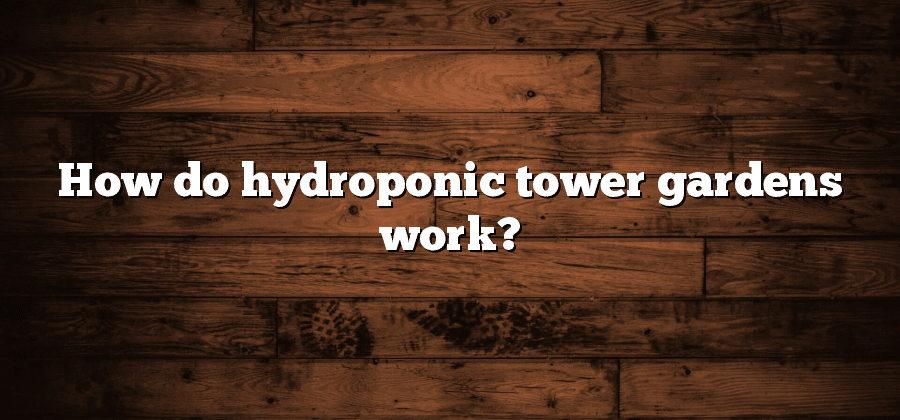Understanding Hydroponic Tower Gardens
Hydroponic tower gardens have gained popularity among gardening enthusiasts in recent years. This innovative gardening system allows plants to grow efficiently without the use of soil. Instead, plants are grown in nutrient-rich water solutions, providing them with all the essential elements they need for healthy growth.
One of the key benefits of hydroponic tower gardens is their space-saving design. These systems are typically vertical, allowing gardeners to maximize growing space in a small area. This is particularly advantageous for urban dwellers or those with limited garden space. Additionally, the vertical design promotes better air circulation and sunlight exposure, which can enhance plant growth and reduce the risk of diseases. By understanding the concept of soilless gardening and exploring the components of a tower garden, one can successfully embark on the journey of vertical gardening and reap its numerous benefits.
The Concept of Soilless Gardening
Soilless gardening, as the name suggests, is a revolutionary concept that challenges the traditional methods of gardening. In this innovative approach, plants are not grown in conventional soil, but rather in a controlled environment where all the necessary nutrients are provided directly to the roots. This method eliminates the need for traditional gardening constraints such as soil quality, limited space, and seasonal limitations. Instead, it allows for year-round cultivation in any location, making it an ideal option for urban gardening or areas with poor soil conditions.
One of the key components of soilless gardening is the use of hydroponic systems. These systems are designed to create an optimal growing environment for plants, where water, nutrients, and oxygen are carefully balanced to promote vigorous growth. The absence of soil also reduces the risk of soil-borne diseases and pests, resulting in healthier plants that require fewer pesticides or chemicals. Additionally, the controlled environment allows gardeners to regulate temperature, pH levels, and lighting to maximize plant growth and optimize yields. Soilless gardening truly opens up a world of possibilities for avid gardeners and plant enthusiasts, empowering them to grow their favorite plants and crops in a highly efficient and productive manner.
Vertical Gardening with Tower Systems
Vertical gardening with tower systems is a highly efficient and innovative method of cultivation that is gaining popularity among urban gardeners and small-space growers. These tower systems are designed to maximize planting space by utilizing vertical structures, allowing you to grow a variety of crops in a compact area. With the development of soilless gardening techniques, tower systems have become a practical solution for those who lack the traditional gardening space.
Tower systems consist of multiple stacked levels or containers that can hold plants. They are specially designed to provide optimal growing conditions, including adequate sunlight, water circulation, and nutrient delivery. These systems often incorporate hydroponic or aeroponic techniques, which involve growing plants in a soilless medium or misting them with nutrient-rich water. By eliminating the need for soil, tower systems reduce the risk of soil-borne diseases and pests, making them a clean and environmentally friendly option for vegetable and herb cultivation.
With vertical gardening, you can create stunning and efficient garden displays in even the smallest of spaces. Tower systems offer numerous advantages, such as increased yield per square foot, easy accessibility for pruning and harvesting, and reduced water and fertilizer usage. Whether you are a passionate home gardener looking to maximize your harvest or an urban dweller with limited outdoor space, vertical gardening with tower systems provides an innovative and practical solution for growing plants in a sustainable and efficient manner.
Exploring the Components of a Tower Garden
Tower gardens are innovative systems that allow for vertical gardening in small spaces. They are composed of several key components that contribute to their success.
One of the main components is the tower itself, which is typically made of durable materials such as plastic or PVC. The tower is designed with multiple planting pockets where plants can be grown. These pockets are strategically placed to provide optimal access to sunlight and airflow. The size and shape of the tower can vary depending on the specific model, but its overall purpose remains the same.
In addition to the tower, a crucial component of a tower garden is the nutrient reservoir. This is where a nutrient solution is stored and distributed to the plants. The solution is made up of water and essential nutrients that are necessary for plant growth. The reservoir usually includes a submersible pump, which helps to circulate the nutrient solution throughout the tower. This ensures that all the plants receive the necessary nutrients in a consistent manner. Without a properly functioning nutrient reservoir, plants in a tower garden would not be able to thrive.
Another important component of a tower garden is the growing medium. Instead of soil, tower gardens use a soilless growing medium to support plant roots. This medium helps to retain moisture and nutrients, while also providing stability for the plants. Common examples of soilless growing mediums include coconut coir, rockwool, and perlite. The choice of growing medium can depend on factors such as the type of plants being grown and the specific requirements of the tower garden system.
The final component that should be mentioned is the irrigation system. Tower gardens typically utilize a dripper system, where water is delivered directly to the plants’ root zones through small tubes. This allows for targeted and efficient watering, reducing waste and ensuring that plants receive an adequate water supply. The irrigation system can be adjusted to meet the specific needs of different plants, providing them with the appropriate amount of water at regular intervals.
Overall, understanding the components of a tower garden is essential for successful vertical gardening. With the tower, nutrient reservoir, growing medium, and irrigation system working harmoniously together, individuals can enjoy the benefits of growing their own plants in a compact and efficient manner.






